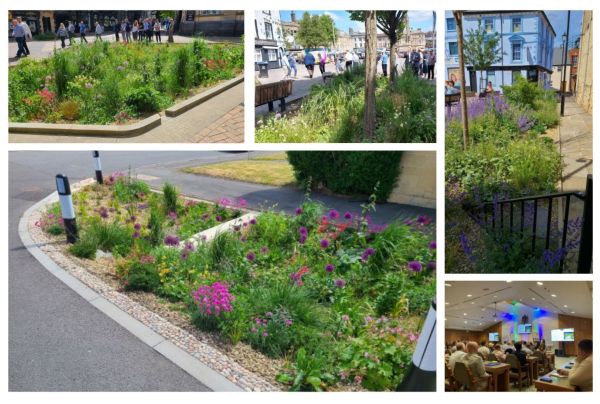
The Mansfield Sustainable Flood Resilience project is the largest of its kind to be installed in the UK.
In a groundbreaking, catchment wide scheme, Severn Trent Water, working with Mansfield District Council and Nottinghamshire County Council, invested £76m to install more than 340 sustainable drainage solutions across Mansfield, as part of their bid to reduce the amount of surface water entering the sewerage system.
The lessons learned from the planning, implementation and management of this project serve as a blueprint for combatting urban flooding in towns and cities throughout the UK.

Welcome and introduction
The day started with a welcome by Adrien Baudrimont, Senior Research Manager, CIRIA, followed by scene setting from Adam Boucher, Operations Lead – Green Recovery, Mansfield Sustainable Flood Resilience Project, Severn Trent. After this brief introduction it was time to climb aboard the coaches and see some of these wonderful interventions in situ.
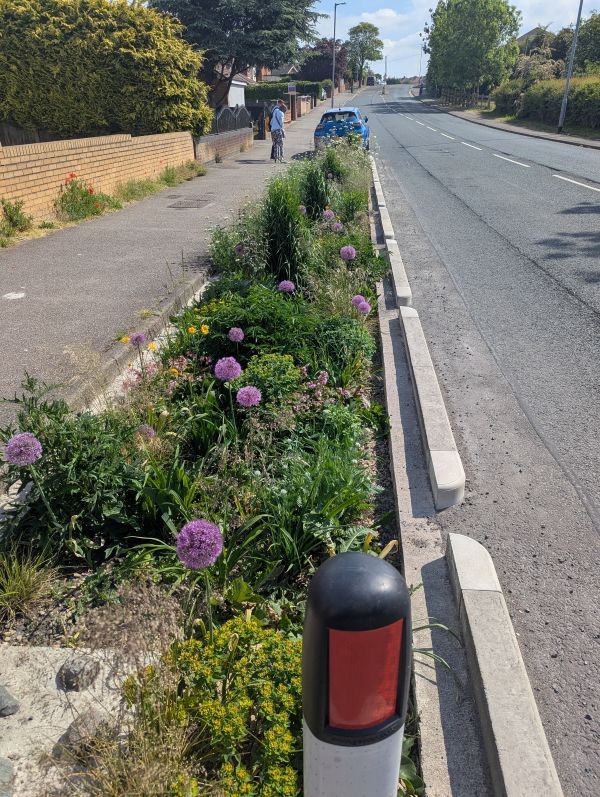
Eakring Road Roadside Rain Garden
The first stop was at a roadside rain garden, resplendent with Alliums, Geraniums, Yarrow, and more, together with attendant bees. Further up the road, permeable paving had been implemented as roadside parking places. We were told how this particular area of carriageway and the houses, at sub-highway level, flooded “pretty much every time it rained”. The rain garden, at an estimated 1m wide and 3m long, looked like a small intervention, but the 950mm depth of a mixture of storage, transition and growing media, plus 150mm of freeboard was certainly doing the job of controlling the flooding on this stretch of road.
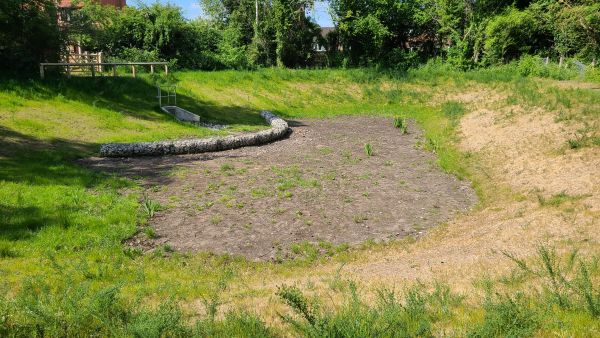
Goodwood Way Detention Basin
A short walk through a 1990’s residential development followed. We passed through a gate into an area, which was previously predominantly bramble scrub, with a few paths through made by dog walkers. The area had been transformed by clearing the scrub (this one was pre-BNG regulations) and taking out 1405m3 of material to create a detention basin. The basin, with it’s 1:3 /1:4 sides was not ‘developer SuDS’, i.e. a fenced off hole at the end of a pipe, but rather an area of transient water (currently dry) - a large ephemeral pond, without any kind of fence whatsoever.
Questions were asked about the lack of fencing. There does seem to be apprehension from stakeholders about the introduction of what are often perceived as standing waterbodies within developments. RoSPA (Royal Society for the Prevention of Accidents) had assessed the plans and given them the green light. Extensive and effective stakeholder communications had assured the community that this was a good, safe intervention. It was clearly well used; a great piece of amenity space, with new footpaths, and evidence of access and play within the empty basin.
The residential development had been built with separate run-off and foul pipes, which, unfortunately, then rejoined into the same pipe further down the Severn Trent network. This intervention has meant that the surface runoff from the hard surfaces within the development now went into the basin via (in my opinion) an incongruous/unnecessary concrete headwall. The water passes through a simple sediment filter, an arc of rocks in chicken wire, and then infiltrated to ground, rather than entering the sewer network.
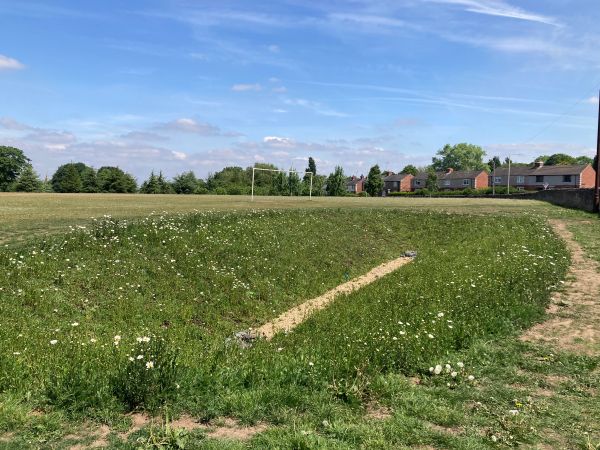
Crow Hill Lane Bioswale
Next stop, Crow Hill Lane, to visit a playing field with a bioswale, set back behind the goal posts, planted up with transformational Pictorial Meadows seed mix, currently flowering white, with the odd spattering of pink scabious.
The base of the bioswale was bare aggregate, and the inlet (from the adjacent road) was via ACO SuDS Swale Inlets. The detained water was prevented from becoming too deep by an outlet which directed any excess water back into the piped network. There was evidence of incidental recreational use, with the edges of the bioswale evidently providing seating for groups of people.
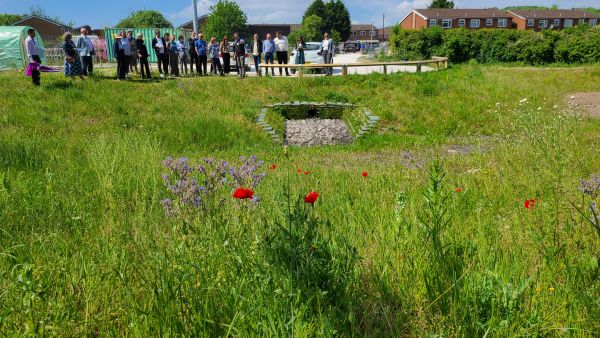
Newcastle Street Detention Basin
We walked up towards Yeoman Hill Skate Park and took a left into the allotments. Here, at the end of a track, we arrived at a large detention basin. This basin takes the surface water from the adjoining streets and houses. This basin has no outfall to the wider network. Instead the use of a non-return valve, on the inlet, ensures that the water does not push back into the system and allows the basin to reach its optimum level. The basin is surrounded by a bund on the far side, which prevents excess water flowing downhill into the adjacent housing.
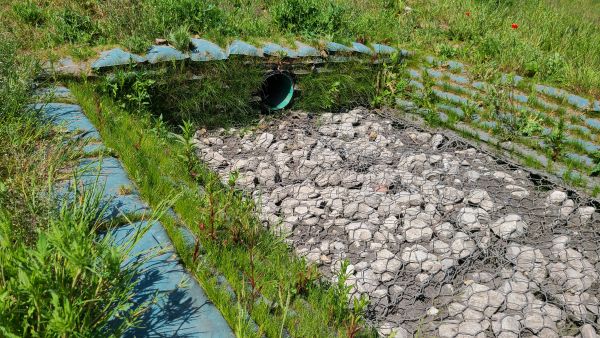
Newcastle Street Detention Basin - Inlet detail
The inlet to this detention basin was constructed using a Geobag-type product which had then been seeded to give a more natural and cohesive feel – something which was to be replicated in many of the basins, rather than the concrete headwalls. Again, the silt trap was a simple but effective wire basket and rock combo.
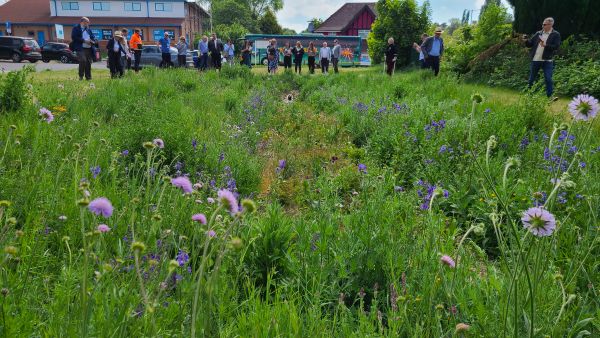
Barringer Road Bioswale
The coach parked at the lower end of Barringer Road and we entered a small parking area with an abundantly planted, lush bioswale. The inlets were the, by now very familiar, ACO SuDS Swale Inlets, from where the water ran onto the wire and rock sediment filter. The runoff from the adjacent roads enters this bioswale via the CKD (combined Kerb and drainage, Beany kerb) along Barringer Road. Unlike the bioswale on Crow Hill Lane, there was no visible aggregate, just a bed of dense vegetation. Two drains were in situ to take any excess water back into the network.
There was no silt trap or filter between the roadside kerb and bioswale inlet, which indicates that all road-based pollution contained in the surface flow would enter the swale. Barrington Road isn’t that busy, but it would be great to know the effect on water quality at an entry and infiltration point.
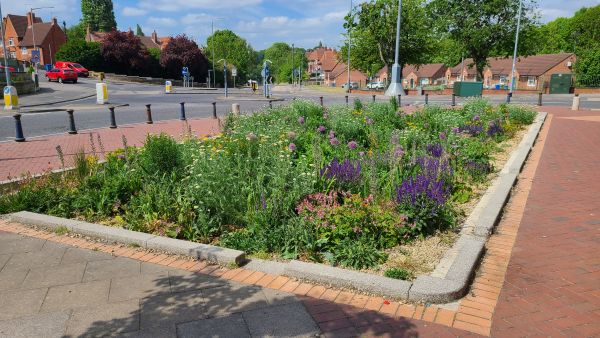
Ravensdale Road rain garden
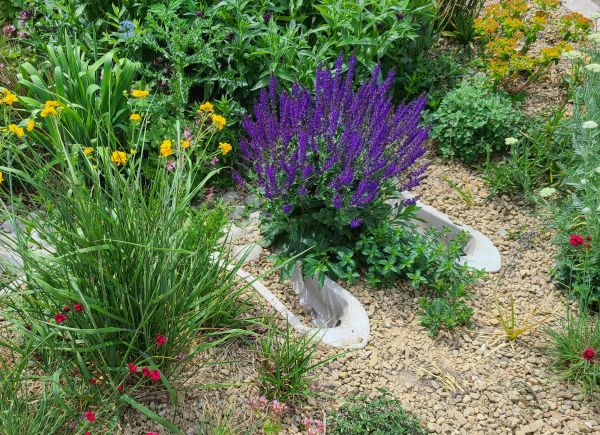
Ravensdale Road rain garden - inlet detail
We crossed Barringer Road and arrived outside the shops on Ravensdale Road, to see two raingardens set into the wide pavement. Water was channelled, from the down pipes of the shops, into the rain gardens, together with inlets taking water from the CKD on the road. A planting scheme including Geraniums, Yarrow, Aliums, Salvia, Geums and Irises brought colour to this pocket of retail on what was previously a large, dull, paved and impermeable surface.
Before and after images of Ravensdale Rd
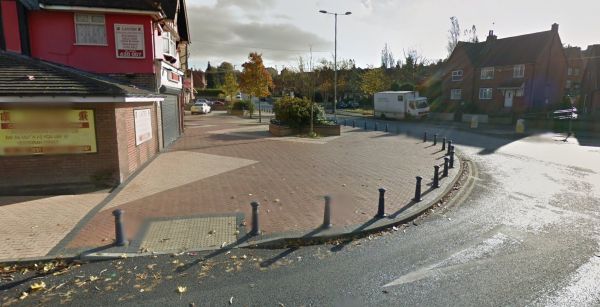
Image credit Google Maps, Street View
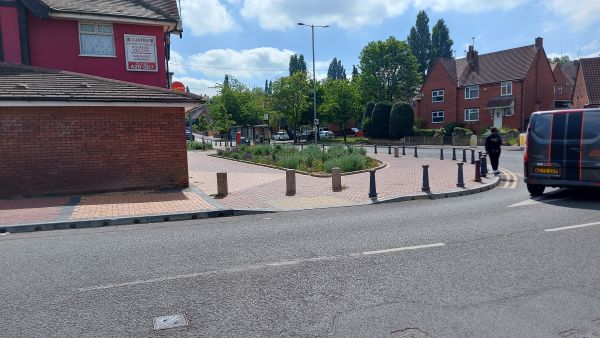
Although designed purely with the purpose of removing volume, the byproduct of ‘amenity’ is abundantly obvious.
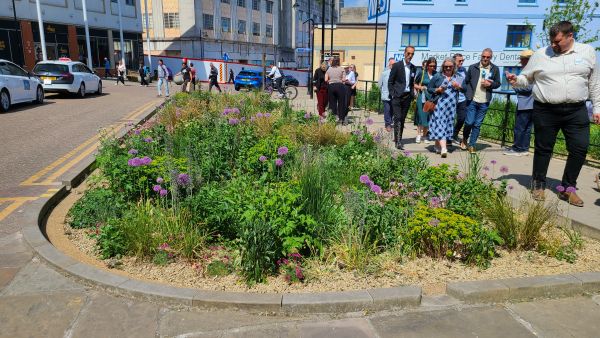
Mansfield City Centre, Queen Street
Another trip on the coach brought us into Mansfield City Centre, where we had a short walking tour of the Rain Gardens within two areas of the public realm. We were joined by Zac Tudor from Arup, who spoke about the planting scheme of the rain gardens and the type of planting media used.
Starting out on Queen Street, we saw an area, which was previously a parking bay, now a street rain garden. Water enters through kerb inlets, which (being located within the city) were Yorkstone kerbs with bespoke inlets rather than the off-the-shelf concrete Marshalls EDENKERB® units that have been installed on rain gardens adjacent to busier carriageways. (We're glad to see these in action on other projects - having helped to develop and trial them in 2B's retrofit rain garden project in Halifax, with Calderdale Council: see Ash Green Community Streets - on site!)

Rain garden in the parklet adjacent to Queen Street
These gardens connected to other gardens further along the side of Queens Walk.
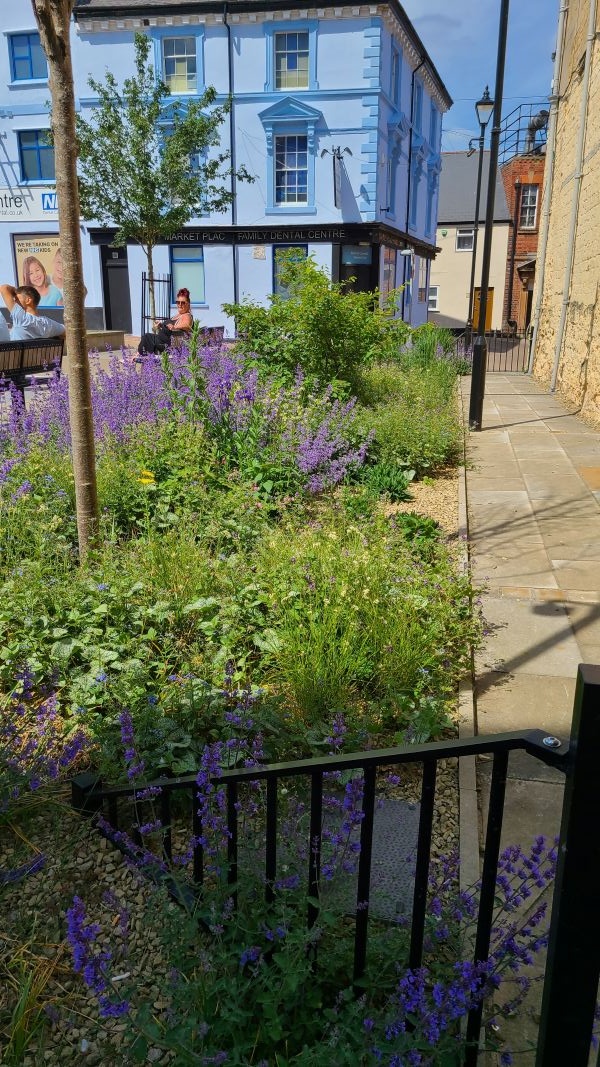
Rain garden on Queens Walk
At this point we saw the only rain-garden-integrated tree, which had clearly suffered during establishment and, let’s say, wasn’t doing too well.
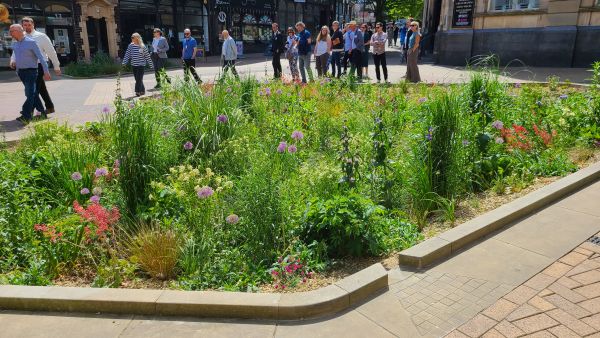
Rain garden in the plaza at the junction of Queens Walk/Market Street
From Queen Street we walked down to the plaza at the junction of Queens Walk/Market Street, and saw large areas of rain gardens. Here there was a discussion around desire-line paths and how the use of a knee-high fence through the centre of one of the gardens had discouraged the public traversing the rain garden during the plant establishment stage. Once the plants had gained a foothold and were flourishing the fence was removed as the dense planting put people off walking through.
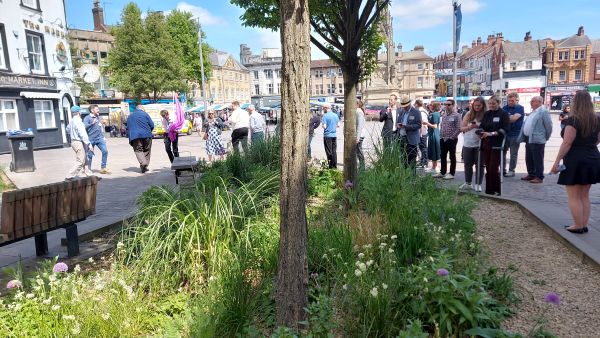
Rain garden in Market Street Plaza
There were established trees in this area, which had been successfully integrated into the rain gardens. The rain gardens here, and on Ravensdale Road, incorporated Hydrorock, a product which has up to 95% hollow space to store water, with the added benefit that it can help to hydrate vegetation using the stored water through capillary action.
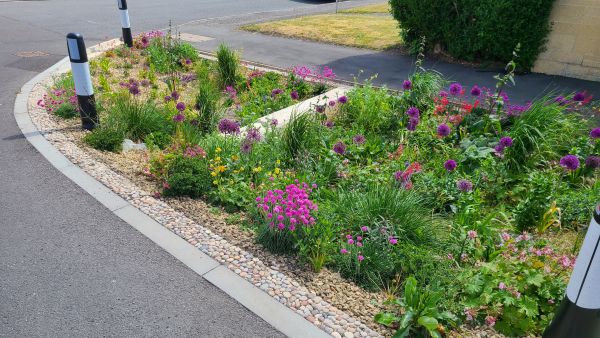
Rain garden on a junction of a residential street
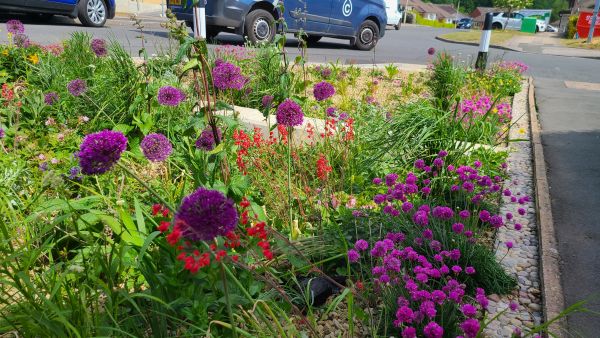
Rain garden - planting detail
These interventions, at four locations, were a small representation of the 340 installed across the city. Some of which we passed along our route, and something to reflect upon as we headed back to the venue to talk about the delivery of the project.
The Mayor had thought that all his Christmases had come at once on receiving the email from Severn Trent, detailing the level of investment available in his city. The offer was a one-off fund, delivered through OFWAT, using the Green Recovery Scheme, post-Covid, that would give the funding for a huge opportunity to make a large and lasting impact on Mansfield’s flood resilience.
Funding
The thing about grants through funding is that the project had to be delivered within a set timeframe. This meant that the time spent to design the interventions needed a streamlined, almost modular approach, with tweaks for site constraints. The time it would take to carry out detailed hydraulic modelling for each site and design interventions on a site-by-site basis was out of the question. There needed to be a ‘mass-manufacturing’ type approach with a template design developed for each type of intervention, whether it be a retrofit roadside rain garden, a verge rain garden, a bioswale or a detention basin. This was an iterative process, 550 design reviews and 350 stage 2 audits were carried out. There were around 8 formal editions of the design standards and approximately 50 interim amendments. Alongside this a 3-page standardised products document was produced.
Desk-based evaluation
The first stage of the project delivery was a catchment wide desk-based evaluation to consider where the interventions would need to be placed, followed by the possible sites being explored further, visited, discounted, or brought forward to the next stage. This desktop site selection was carried out by hand initially, then a site selection tool was developed with Arup which automated this process.
Hydrology
Hydrological risks were assessed - there was a desire to infiltrate wherever possible but there are potential risks to this. Mansfield-wide hydro-geological modelling was undertaken, with further evaluations done in specific areas.
Road safety
Road safety risks were assessed and audits carried out by VIA, (a subsidiary of Notts County Council responsible for the highways). An area-wide 'Section 278' was developed and approved, rather than applications on a location by location basis.
Consultation
There was a huge level of awareness-raising and consultation, with door-to-door visits, and a website saying what works were to happen - when and where.
Further to the initial evaluation of some types of intervention, it was discovered that there were factors which hadn’t been considered that were affecting the cost/return on reduction in volume - one example being the use of permeable paving.
Many retrofit parking bays, using permeable paving, featured on the original plan but, to perform at its best and give the best results, the surface water needs to sheet across a large percentage, preferably all, of the permeable surface. It was soon apparent that, without reprofiling of the carriageway on many of the identified sites, the water would run down the gutter line, meaning that only a small percentage of the paving was able to provide a degree of source control, and not giving the requisite return.
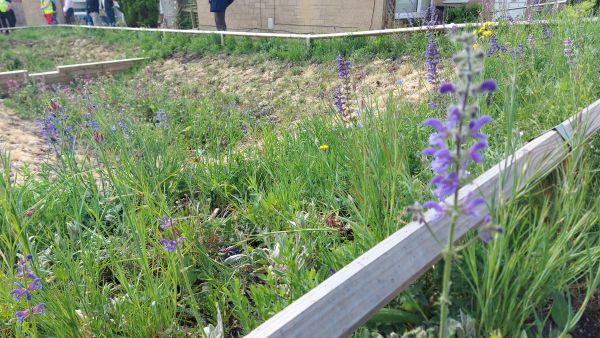
Bioswale on a residential street
We heard how street, or roadside rain gardens, were the interventions with the most issues, and were something which Severn Trent moved away from. Again, due to the cost vs the amount of storage, they were found to be just not viable. Instead, effort was focussed on verge rain gardens and bioswales. Another piece of information, that came out of the consultations, was that the loss of casual roadside parking in some areas was the most contentious issue with the public.
Utilities
With regard to utilities, a RAG status approach was adopted, with some examples given:
Red – High pressure gas main, avoided
Amber - the service should be left exactly as is but with the rain garden built around it
Green – relocate the service into the rain garden, or move the service as necessary.
Land ownership
Severn Trent don’t own the land where the interventions are located. However, a contract was developed with the Council regarding easements instead and they worked with Highways, under S115 of the Water Industry Act, to enable the highway interventions to be created.
Collaboration
Strong co-operation and co-working practices were enabled by key team members from each organisation being located all together in the same office. The high level of collaboration required on this project was very much a key part of its successful delivery.
After some further questions the session was wrapped up and we left, feeling inspired and positive about the potential benefits that the sharing of this experience and the knowledge could bring.
by Johanna Elvidge TMLI